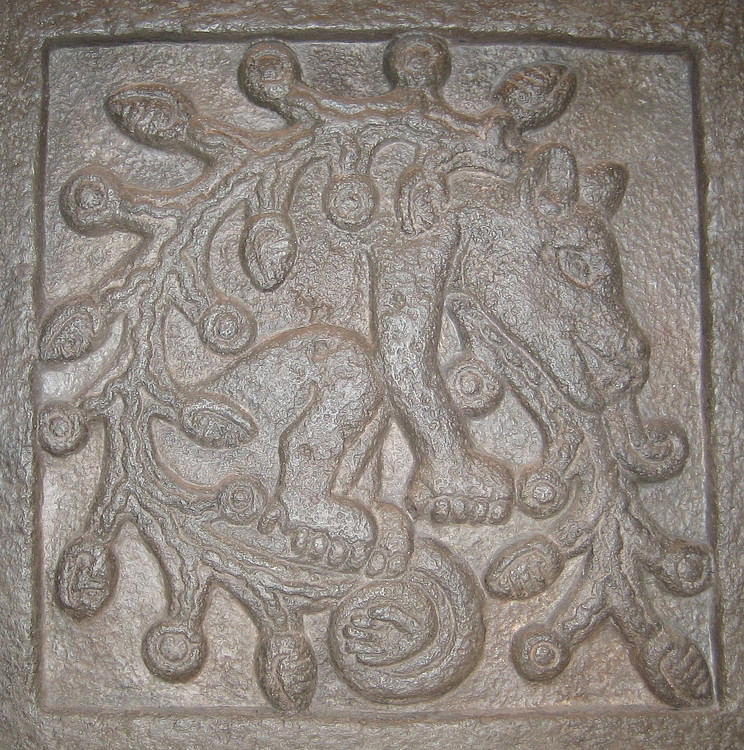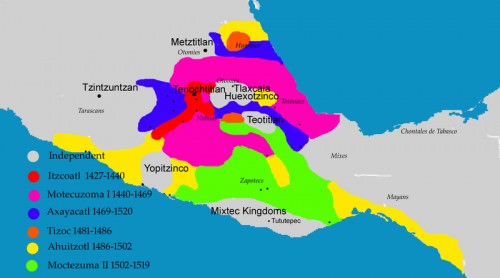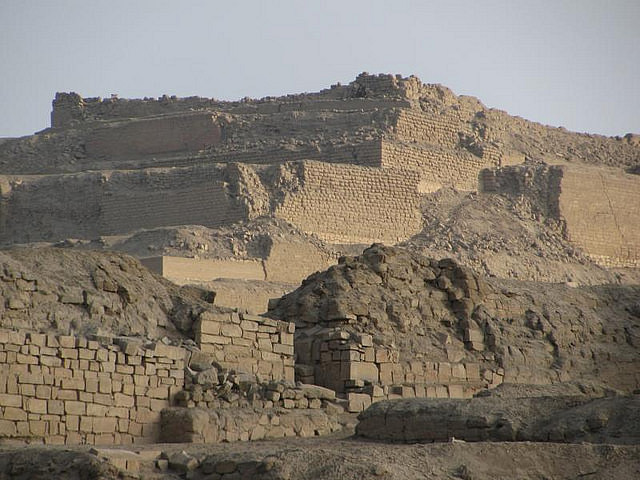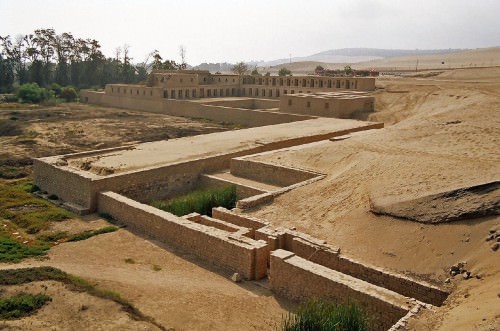Ahuitzotl › Pachacamac » Ancient origins
Articles and Definitions › Contents
- Ahuitzotl › Who Was
- Pachacamac › Antique Origins
Ancient civilizations › Historical and archaeological sites
Ahuitzotl › Who Was
Definition and Origins

Ahuitzotl (Auitzotl) was an Aztec ruler who reigned between 1486 and 1502 CE. He was one of the greatest generals of the ancient Americas and he left to his nephew, Montezuma, an enlarged and consolidated empire which had been ruthlessly terrorised into submissive acceptance of Aztec rule. With huge building projects and victories celebrated by mass sacrifices of captured enemies to honour the gods, the reign of Ahuitzotl was the Aztec Golden Age.
ACCESSION
Ahuitzotl ( pron. A-weet'-zot) was the third son of Aztec king Motecuhzoma I Ilhuicamina (r. 1440-1469 CE). His name, appropriately enough as it would turn out, was associated with a mythical hyper-aggressive otter that lived at the bottom of a lake and ruthlessly preyed on any creature which approached the lake's banks. The creature, often depicted with a human hand at the end of its tail, was used as the name glyph for the king in Aztec commemorative sculpture.
Ahuitzotl took over as the Aztec tlatoani (speaker) or supreme ruler from his half-brother Tizoc (r. 1481-1486 CE) who was poisoned. Tizoc had not been particularly successful in the role after being forced to quash various rebellions and famously losing a battle to the Tarascans. Lord Ahuitzotl was the 8th Aztec ruler and he is described in Aztec texts as youthful, strong, energetic, and audacious. According to the version of his accession recounted by the Spanish chronicler Fray Diego Duran, Ahuitzotl was a mere youth when he took power in 1486 CE and had to be brought from school on the death of Tizoc but he already displayed a great maturity beyond his years. We are also informed that the new tlatoani was helped in his early years by the traditional king's advisor, the Tlacaellel.
AHUITZOTL USED THE SPECTACLE OF HUMAN SACRIFICE TO TERRIFY VISITING RULERS OF NEWLY CONQUERED TERRITORIES & ENSURE THEIR PASSIVE COMPLIANCE TO AZTEC RULE.
The accession of Ahuitzotl is commemorated in a green diorite slab with the year 8 Reed date glyph. On it are both Tizoc and Ahuitzotl while between them is a ball of cactus fibre with cactus needles stuck in it. The two rulers are using needles to let blood from their earlobes in offering to the gods. The blood flows down from the two figures into the gaping jaws of a stylised earth-crocodile creature representing the earth goddess Tlaltecuhtli. The slab now resides in the National Museum of Anthropology in Mexico City.
EXPANDING THE EMPIRE
Ahuitzotl quickly established his reputation as a gifted military leader by winning his first battle in the traditional 'Coronation War ' beloved of Aztec rulers. Leading his army in person and fighting alongside his warriors as he would always do, the Toluca Valley rebellions were quashed, booty taken, and sacrificial victims procured. The victory was celebrated with the largest feast and round of gift-giving the Aztec people had ever witnessed.
Ahuitzotl then proceeded to bring the Gulf Coast territories into line after their stubborn refusal to pay tribute. This was another victory, and Ahuitzotl would go on to win many more. Conquering the central valleys of Oaxaca c. 1494 CE the Aztecs moved as far south as the Guatemalan border, or even beyond, in order to encompass lucrative cacao-producing regions. They also campaigned as far west as the Pacific coast, perhaps in a long-term strategy to outflank the Tarascan forts being established by that hostile nation. The result of this expansion was that Ahuitzotl created the largest area yet brought under Aztec control.

Expansion of the Aztec Empire
Although the Aztec armies concentrated on enemy cities and their empire would only ever be a loose collection of tribute-paying subject states, Ahuitzotl did attempt to establish a more permanent Aztec presence by building Aztec monuments in such conquered cities as Tepoztlan, Malinalco, and Calixtlahuaca. Some local gods were also incorporated into the Aztec pantheon in an effort to further bind the diverse cultures of Mesoamerica. Trade was encouraged in some areas, especially by the pocheca warrior-traders who were given the privileged right to wear jewellery and feathers by Ahuitzotl, such was their importance in his strategy to open up new territories by whatever means suited the situation. At the same time more troublesome peoples (eg the Oztoman and Alahuistan) were ruthlessly and systematically wiped out during the reign of Ahuitzotl.
Ahuitzotl also greatly increased the number of human sacrifices carried out in the various Aztec religious ceremonies designed to appease their gods and celebrate military victories. Duran famously recounts how 80,400 war captives were sacrificed over four days atop the Templo Mayor pyramid temple at Tenochtitlan. Most historians discount this number as impossibly high and impractical, settling on a figure nearer 20,000 but still quite enough to fulfil the apocalyptic descriptions by eye-witnesses of temples, plazas, and streets streaming rivers of blood. The scene of this mass sacrifice is depicted in the Codex Telleriano Remensis. Not only did sacrifices help to appease the gods and ensure a continuation of the Aztec world but Ahuitzotl used the spectacle to terrify the visiting rulers of newly conquered territories and ensure their passive compliance to Aztec rule.
BUILDING PROJECTS
Ahuitzotl, besides imperial expansion, also occupied himself with grand building projects in order to beautify the Aztec capital of Tenochtitlan and, in typical Aztec fashion, establish early on that his reign would bring great prosperity to his people. The most significant such project was the expansion of the Templo Mayor. The new temple was completed in 1487 CE, and it was to inaugurate this giant monument to the rain god Tlaloc and war god Huitzilopochtli that the infamous 80,000 plus captives were sacrificed.

Temple Mayor, Tenochtitlan
Another giant project of Ahuitzotl was the construction of a large canal to bring fresh water from Coyoacan to Tenochtitlan.However, in a version recounted by Duran, the project got off to a bad start when it brought so much water that it flooded the city. The priests blamed the disaster on the fact that Ahuitzotl had rashly killed a ruler of Coyoacan, and so this was revenge from Chalchiuhtlicue, the water goddess.
DEATH & SUCCESSORS
Ahuitzotl's reign came to a mysterious end when he contracted a strange and fatal disease, dying in the year 10 Rabbit. In another version of events the king died from a blow to the head while he was trying to escape the flood at Tenochtitlan. Death by a wasting disease suggests that he may well have been poisoned, like his predecessor, such was the competition between members of the ruling family to possess the title which permitted the holder semi-divine status. In a lavish ceremony, Ahuitzotl was cremated on a funeral pyre atop the Templo Mayor and his ashes buried beneath the nearby sacred precinct.
Ahuitzotl would pass on a prosperous empire to the next and tragically last true Aztec ruler, his nephew Motecuhzoma Xocoyotzin (Montezuma) who faced and was murdered by the visitors from the Old World in 1520 CE. During the chaos of the Spanish conquest, Ahuitzotl's son Cuauhtemoc seized power and resisted the invaders until 1525 CE. Even after his death, the legend of Ahuitzotl the great warrior held strong for his son dressed one of his men in the regal clothes of his father, which inspired the Aztec army to a rare, if only temporary, victory during the long siege of Tenochtitlan.
Pachacamac › Antique Origins
Definition and Origins

Pachacamac, located on the coast of Peru and 32 km south of Lima, was an important sacred site, oracle, and place of burial, which was visited by pilgrims of many ancient Andean cultures, including the Incas. The site, active for over 2,000 years, was named after the god of the same name (Pacha Kamaq) who was worshipped there and considered the 'Maker of the Earth' by coastal peoples.
SACRED SITE OF PACHACAMAC
Pachacamac, located in the Lurin Valley, may have been in use as a sacred oracle site from the 1st millennium BCE while its settlement began sometime in the early 1st millennium CE. The god Pachacamac, also known as the 'Maker of the Earth', was a creator god who was also associated with earthquakes. In coastal mythology, Pachacamac had defeated the rival creator god Con who had stopped all rainfall as punishment for humanity's wickedness. Pachacamac then changed the existing human race into animals and created a whole new race of men and women. In some versions of the myths the god sent four stars to earth, the two male stars became the kings and nobility while the two female stars became the commoners.
The god's sacred wooden statue was worshipped at the site, situated inside a large temple complex built on a stepped earthen platform. This structure is contemporary with the Moche and Nazca civilizations (200 BCE – 600 CE). Built overlooking a colonnaded plaza and sitting on an eight-level platform on a natural hill, the temple buildings must have dominated the site. Each level of the adobe brick platform is around one metre high, and they were painted in bright colours with plant and animal designs. The figures were made more striking by outlining them in black. A set of artist's brushes (of human hair and reeds) and a bag of pigments were found buried at the site in 1935 CE. The temple was well-maintained as some areas of decoration show as many as 16 re-coats. Buildings on the highest platform were arranged around a courtyard, and some were used as accommodation.
THE SACRED SITE & ORACLE OF PACHACAMAC HAS BEEN DESCRIBED AS THE MECCA OF ANCIENT PERU.
THE ORACLE OF PACHACAMAC
The site attracted pilgrims from far and wide to consult its oracle although just how this functioned is not known in detail. We know that a High Priest interpreted the oracle from the privacy of a chamber only he was permitted to enter. Pilgrims had to undergo many weeks of initiation, fasting and cleansing rituals before they could be considered worthy of consulting the oracle.They were also expected to make offerings such as foodstuffs, coca, textiles, and any other precious goods they could afford.Indeed, the priests of Pachacamac established a network of subsidiary shrines throughout the region which extracted tributes from local populations. As at ancient oracles the world over, questions posed would have concerned the weather for agricultural purposes, warfare, health issues, family problems, and so on.
Such was the popularity of the site that the historian Alden Mason described Pachacamac as 'the Mecca of Peru'. This is attested by the finds in tombs of pottery and textiles coming from many different cultures such as the Lambayeque, Nazca, Wari, Tiwanaku, and Chimu. Eventually, the religious buildings spread with many shrines to lesser deities and a residential area sprang up to cover an area of 4 square miles (c. 10 square km). It thus became the largest centre in central and southern Peru. In the residential zones many of the floors and column bases, which must have supported roofs of matting, survive.

Nunnery, Pachacamac
UNDER INCA RULE
The Incas took over the site during the reign of Thupa Inka Yupanki (1471 - 1493 CE) and, in typical fashion, incorporated it and the deity Pachacamac into the Inca religion. They built a temple dedicated to the Inca Sun god Inti with whom Pachacamac was given, unusually for the gods of conquered peoples, equal status. Constructed on a six-level earthen platform and painted red, the temple was actually two parallel rectangular buildings measuring 52 x 23 metres and reaching a height of 7.3 metres. Used as an accommodation for priests the walls have many niches and are decorated with animal paintings. Other Inca structures include a large colonnaded residence for holy women known as the 'Painted Building' ('Nunnery'), a large raised plaza for pilgrims to congregate in, and the residential section of the site known as Tauri Chumbi.
Excavations at the Sun temple's entrance and inside it have revealed a burial space made by the Incas containing 20 young sacrificed women. Artefacts buried with them suggest the girls were of coastal origin. We also know that human sacrifices were made to Pachacamac in order to appease him following the presence of this new rival Inti. The people of Pachacamac, no doubt because of the antiquity of the oracle and the importance of the site to many Andean cultures, were given a higher degree of autonomy than most conquered areas by their Inca overlords.

Textile Fragment, Pachacamac
LATER HISTORY
The site's oracle continued to be consulted by the Incas but lost royal favour when it wrongly predicted that Washkar would win the civil war against Atahualpa between 1526 and 1532 CE. Accordingly, the latter ruler gave permission for Pizarro to send his brother to destroy the statue of Pachacamac. As with any Inca tombs they could find, the Spanish almost certainly would have looted the site as well.
Pachacamac was damaged by further looting and environmental factors over the centuries so that its original form has been difficult to establish. Although parts have been excavated, indeed, the site was the first in Peru to be investigated by archaeologists, some of the modern reconstructions at the site are not necessarily an accurate replica of the original buildings, notably the 'Nunnery' structure. Nevertheless, portions of its well-made walls which used the typical Inca method of neatly fitted stones without mortar, can still be admired. Artefacts excavated from tombs, remarkably well-preserved in the dry desert climate of the region, include richly painted pottery and fine textiles with bold geometrical designs, much like those of the Nazca.
LICENSE:
Article based on information obtained from these sources:with permission from the Website Ancient History Encyclopedia
Content is available under License Creative Commons: Attribution-NonCommercial-ShareAlike 3.0 Unported. CC-BY-NC-SA License